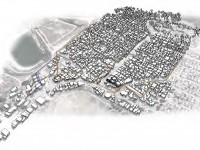Urban Upgrading
Sustainable Housing
Informal Housing
Location: Langrug, Stellenbosch, South Africa
Actors: Informal Settlement Network (ISN)
Stellenbosch Municipality
Residents of Langrug
Community Organisation Resource Center (CORC)
South African Slum/Shack Dweller’s International Alliance (SDI Alliance)
Year: 2010-2012
Background: Stellenbosch Municipality in Western Cape Province, South Africa, is world-renowned for the Franschoek winelands, luxury homes, and restaurants. It also hosts Langrug, an informal settlement of 1,858 homes which between 2011 and 2012 undertook a community-driven upgrading process known as re-blocking. The residents of this dense flood- and fire-prone settlement are responding to the frustration born out of a national housing deficit. Despite the housing gains made since apartheid, some 2 million South Africans live in informal settlements and slums throughout the country, primarily in urban centres. In Stellenbosch, public housing provision is slow: the Informal Settlement Network (ISN) estimates that it would take 100 years to meet the municipality’s housing needs at current construction rates. In the meantime, the poor conditions within Langrug fostered crime and created an unsanitary environment: grey water trickling into a neighboring farm caused unending friction between the farmer, municipality, and Langrug.

Project: In 2009, ISN and CORC were approached by municipal officials to act as intermediaries between the city and Langrug; it was hoped the NGOs could help overcome the decades of mistrust between Langrug residents and the municipality, and thus spark the reblocking process. Following two years of establishing a partnership, upgrading of informal settlements really began in late 2010 with the signing of a Memorandum of Understanding between the City Council, mayor, municipal officials, and the SDI Alliance, an umbrella non-profit organization aiming to improve the living conditions of the urban poor which includes ISN/CORC. The Memorandum established an institutional arrangement between signatories, as well as the intervention and action plan to upgrade communities in Stellenbosch, beginning with the pilot site of Langrug.
Active in informal communities throughout the country, ISN was able to demonstrate to residents of Langrug the success of the reblocking process in the nearby community of Philipi. Following this and workshops explaining the intricacies of reblocking, Langrug residents decided to move ahead with re-blocking, a process which, according to SDI, “re-arranges shacks in densely-packed settlements to open up common public space, access roads, and basic service infrastructure installation.” Re-blocking allows communities to rebuild on the land where they live, avoiding resettlement and preserving social and economic ties. It was agreed that re-blocking would occur incrementally, block by block. This “in-situ” community upgrading means that at any one time only a few infrastructure and household improvements would be taking place, preserving daily rhythms and avoiding mass dislocation.
From the outset, integrating shack dwellers and local leadership into the upgrading process was a key objective. The first step was to conduct a thorough survey of Langrug (known as an enumeration) in order to collect basic demographic data and assess the deficits in critical infrastructure, such as water taps and toilets. Undertaken by local volunteers, the enumeration revealed the extent of the underprovision of services in Langrug: in one subdivision, there were no toilets and only one tap for 604 people/318 shacks. The enumeration process not only better connected and organized the community, but also allowed it to begin a dialogue on what residents needed from the municipality and where.
Some findings from enumeration| “Slum” Name | Langrug |
| Population | 4,088 |
| Age of settlement | 16-17 years |
| Type of structures | All shacks |
| Number of shacks | 1,858 |
| (about 41% have indicated female heading the household) | |
| Land ownership | City Council |
Results: In addition to a host of planned infrastructure works, the partnership between Langrug, the NGOs, and the Municipality has shown that such a community-driven upgrading process can indeed lead to successful improvements for a poor community. As a pilot, the Langrug has laid the groundwork for the upgrading of other settlements. Additionally, the relationship between the Municipality and Langrug residents has never been stronger: productive, trusting dialogue now exists, reducing community friction to urban planning projects while also providing the community more voice and veto power in such projects. This new relationship best showed itself when the Municipality approached Langrug residents about installing a road, which required the resettlement of 14 families. Rather than sparking a series of protests and top-down eviction orders, a participatory approach was taken to resettle the families that had the full support of the community.
Sources:
I2UD Vice President Mona Serageldin was informed of the Langrug re-blocking process during her recent work in South Africa. Stellenbosch officials provided her with a PowerPoint presentation on the project.
More on Re-blocking from SDI: http://www.sdinet.org/blog/2012/07/13/re-designing-city-one-shack-cluster-time/
Supplementary information was provided from by in-depth Narrative of the re-blocking in Langrug, courtesy of SDI: http://www.sdinet.org/media/upload/documents/Langrug_Booklet.pdf


